Walmart halts H-1B visa offers amid Trump’s $100,000 fee increase - Bloomberg
First Abu Dhabi Bank PJSC (ADX:FAB), the UAE’s largest bank by assets, reported outstanding first-quarter results on April 29, 2025, with net profit after tax surging 23% year-over-year to AED 5.13 billion ($1.4 billion), driven by strong business momentum and diversified income streams.
Quarterly Performance Highlights
FAB delivered exceptional performance across key metrics in Q1 2025, with profit before tax increasing 22% year-over-year to AED 6.13 billion and return on tangible equity (RoTE) reaching 20.4%, up from 17.4% in the same period last year. The bank’s operating income grew 11% year-over-year to AED 8.81 billion, supported by resilient net interest margins and strong non-funded income.
As shown in the following summary of key highlights from the quarter:
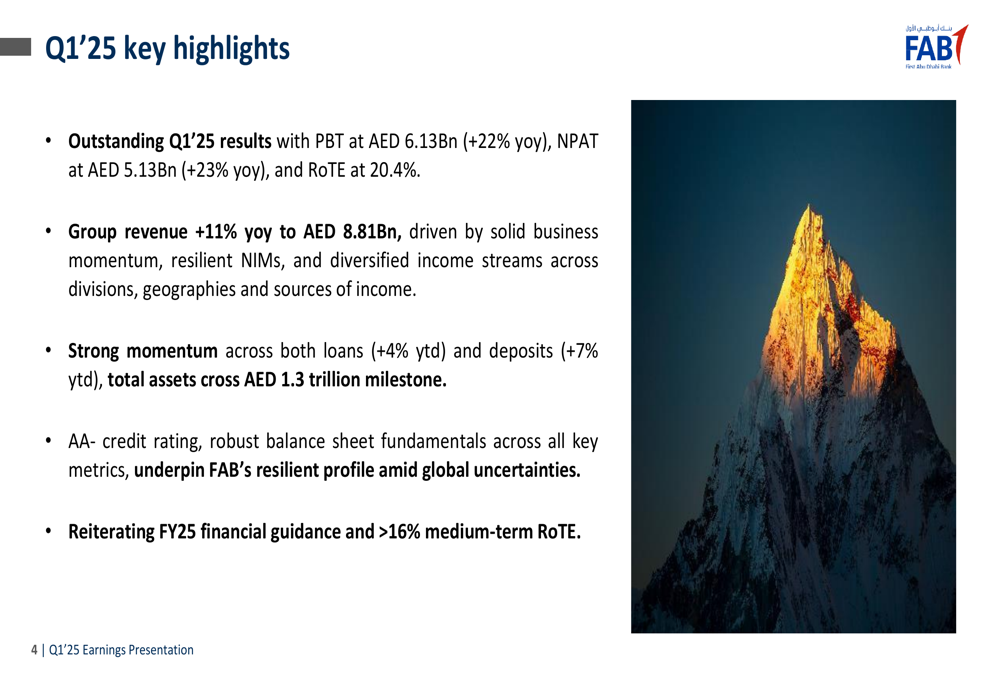
The bank’s balance sheet continued to strengthen, with total assets crossing the AED 1.3 trillion milestone, representing a 6% year-over-year increase. Loans and advances grew 8% year-over-year and 4% year-to-date, while customer deposits increased 4% year-over-year and 7% year-to-date, demonstrating solid business momentum across the franchise.
The following financial performance table provides a comprehensive overview of FAB’s Q1 2025 results:
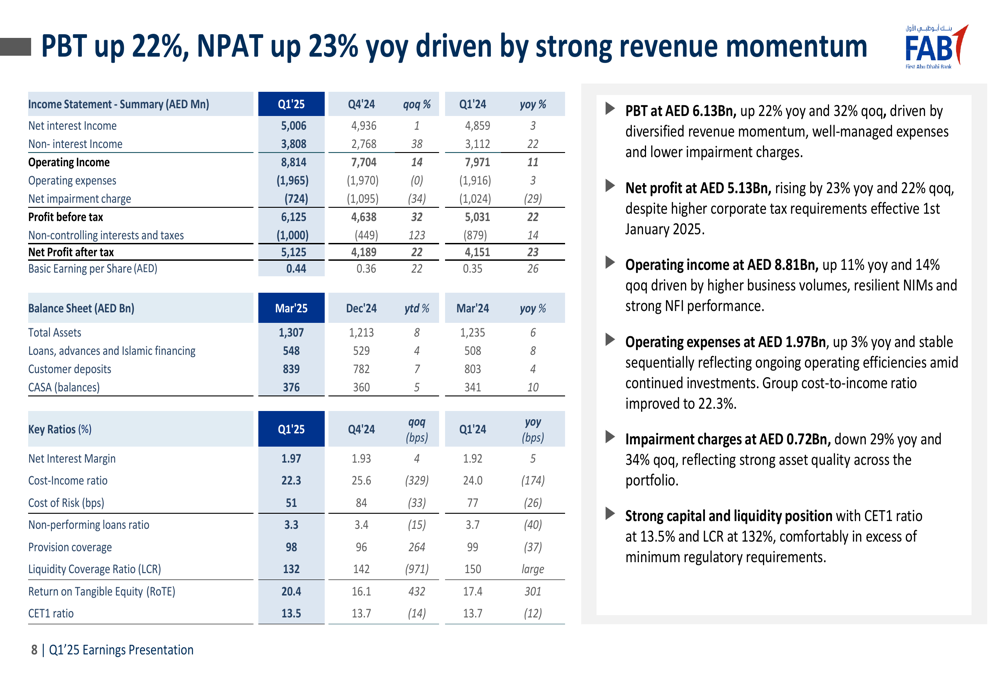
FAB’s performance in Q1 2025 has positioned the bank well to achieve its full-year guidance. The bank is on track with its 2025 financial targets across all key metrics, including loan growth, cost of risk, provision coverage, return on tangible equity, and CET1 ratio.
As illustrated in this comparison of guidance versus actual results:
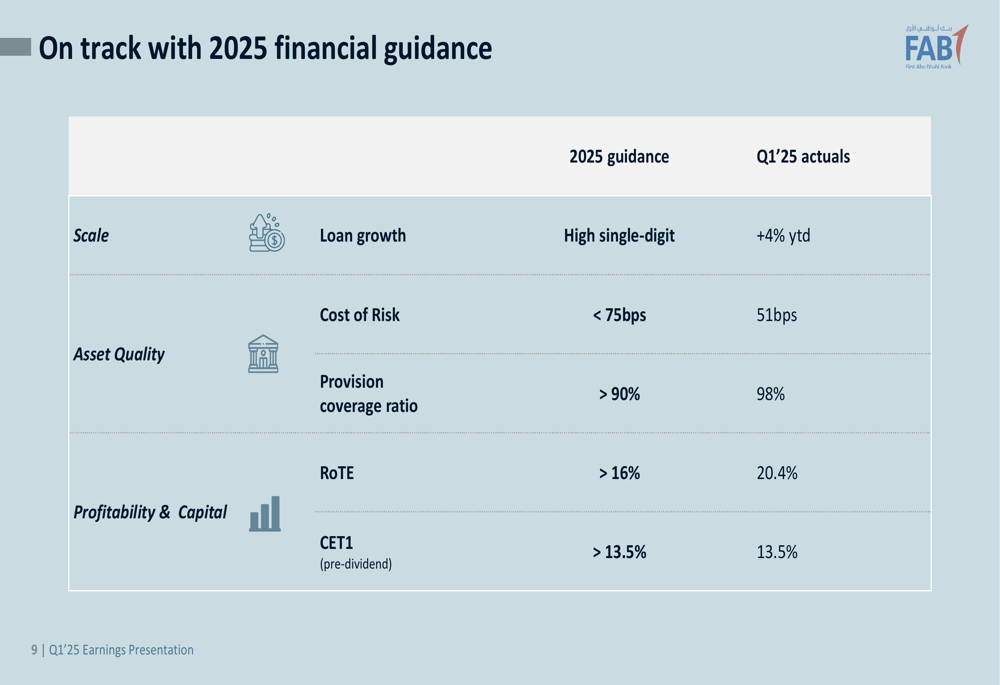
Strategic Initiatives
FAB continues to focus on diversification, international expansion, and digital transformation as key pillars of its strategy. The bank has reorganized its operating segments to align with its customer-centric approach, while leveraging its presence across 20 markets to build new client relationships along key economic corridors.
The following overview highlights FAB’s strategic progress across four key areas:
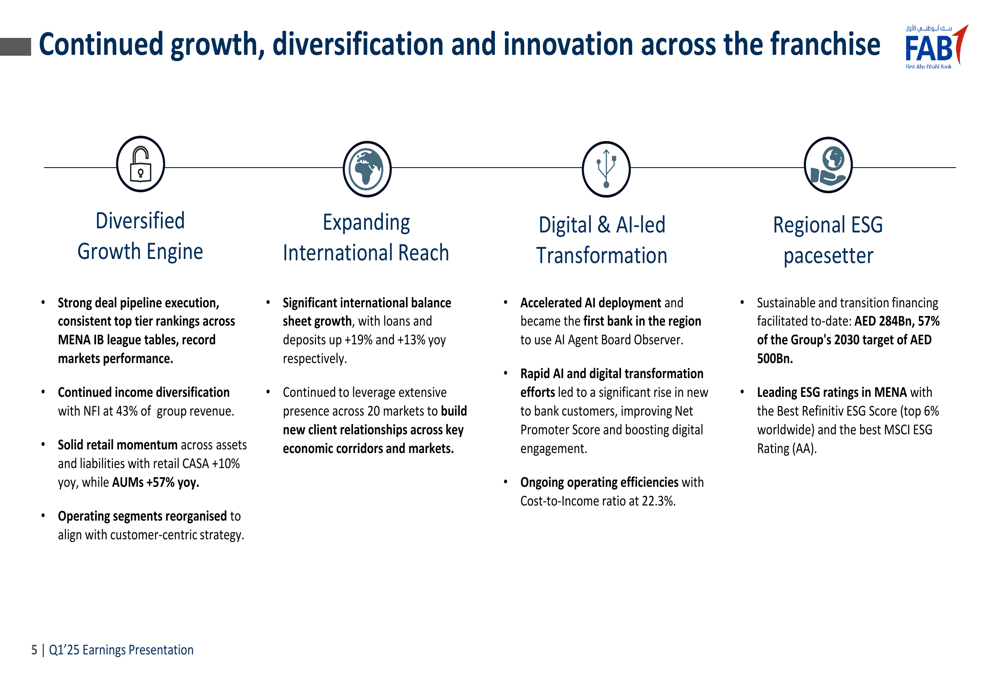
The bank’s revenue diversification strategy is yielding positive results, with non-funded income contributing 43% of group revenue in Q1 2025. By division, Investment Banking and Markets generated AED 3.06 billion (+15% yoy), Wholesale Banking contributed AED 1.44 billion (+12% yoy), and Personal, Business, Wealth and Privileged Client Banking Group delivered AED 3.15 billion (+11% yoy).
The revenue breakdown by division, geography, and income source is illustrated below:
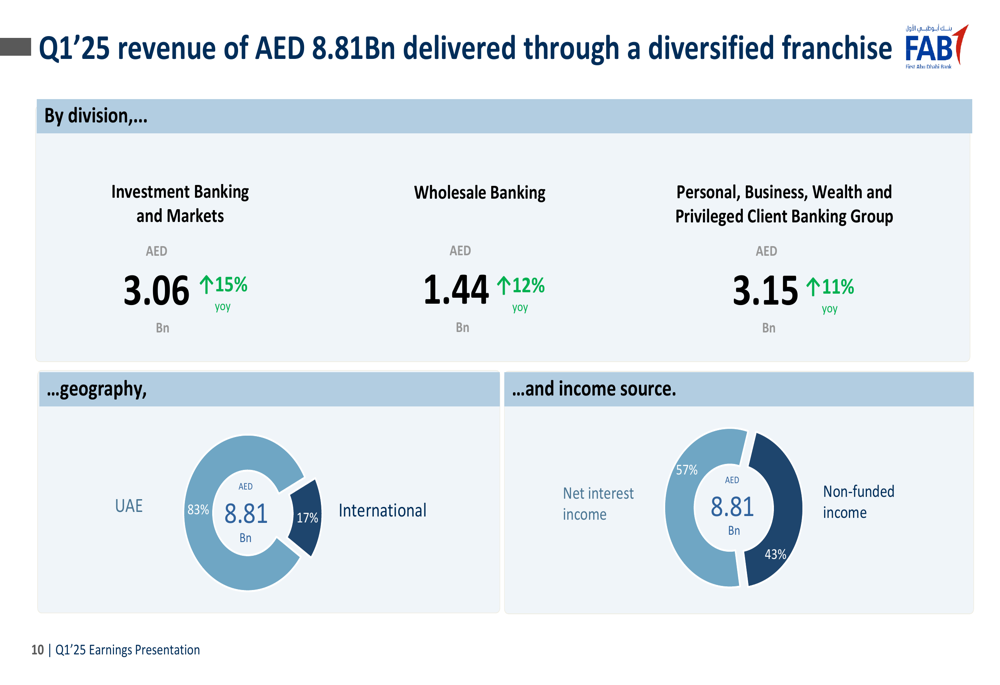
Detailed Financial Analysis
FAB maintained resilient net interest margins (NIM) at 1.97% in Q1 2025, up 5 basis points year-over-year and 4 basis points quarter-over-quarter. This improvement, combined with strong business momentum, drove net interest income above AED 5 billion for the quarter.
The bank’s non-funded income showed significant strength, with fees and commissions increasing to AED 1.2 billion in Q1 2025 from AED 981 million in Q1 2024. FX and other investment income also improved substantially to AED 2.34 billion from AED 2.05 billion in the same period last year.
As shown in this breakdown of non-funded income performance:
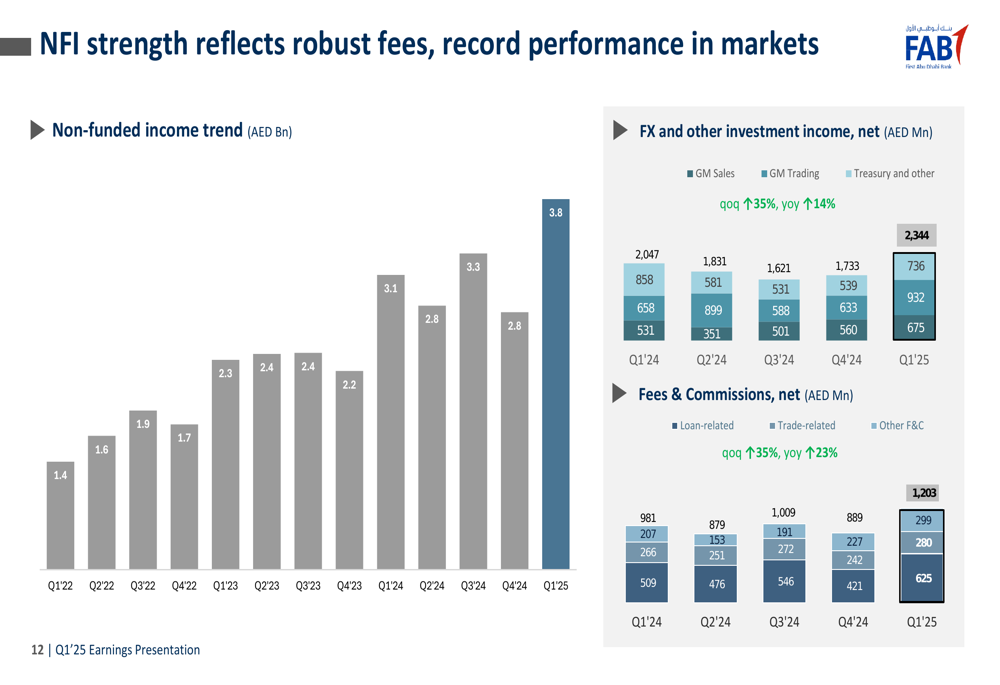
FAB continued to demonstrate cost efficiency despite ongoing investments, with a cost-to-income ratio of 22.3% in Q1 2025, improving from 24.0% in Q1 2024. Operating expenses increased 3% year-over-year to AED 1.97 billion but remained stable sequentially, reflecting the bank’s focus on operational efficiency.
The bank’s asset quality metrics showed significant improvement, with the non-performing loans (NPL) ratio decreasing to 3.3% from 3.7% in Q1 2024. Net impairment charges declined 29% year-over-year and 34% quarter-over-quarter to AED 724 million, resulting in a cost of risk of 51 basis points, down from 77 basis points in Q1 2024.
The following chart illustrates the improvement in asset quality metrics:

FAB maintained a strong balance sheet with robust liquidity and capital positions. The bank’s CET1 ratio stood at 13.5%, slightly down from 13.7% in Q1 2024 but still well above regulatory requirements. The liquidity coverage ratio (LCR) was 132%, providing ample liquidity to support growth.
The strong balance sheet is evidenced by the following metrics:
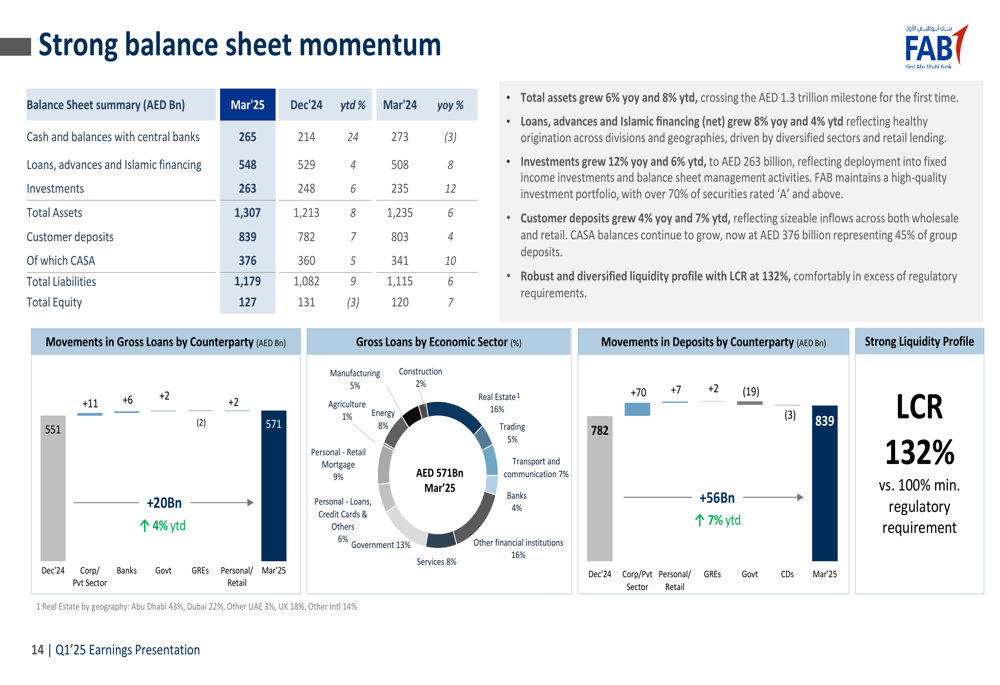
Forward-Looking Statements
Looking ahead, FAB reiterated its financial guidance for 2025, targeting high single-digit loan growth, cost of risk below 75 basis points, provision coverage above 90%, return on tangible equity exceeding 16%, and a CET1 ratio above 13.5%. The bank also maintained its medium-term RoTE target of over 16%.
FAB expects to maintain its resilient profile amid global uncertainties, supported by its AA- credit rating (the strongest in the region), robust balance sheet fundamentals, and diversified banking franchise. The bank’s in-house view forecasts UAE real GDP growth of approximately 5.2% in 2025, with oil prices around USD 70 per barrel and up to two interest rate cuts during the year.
The bank’s strategic focus on sustainable finance continues, having facilitated AED 284 billion in sustainable and transition financing to date, representing 57% of its 2030 target of AED 500 billion. FAB maintains leading ESG ratings in the MENA region, with the best Refinitiv ESG Score (placing it in the top 6% worldwide) and the best MSCI ESG Rating (AA).
As First Abu Dhabi Bank enters the remainder of 2025, its strong Q1 performance, diversified revenue streams, and robust balance sheet position it well to navigate the evolving economic landscape while continuing to deliver value to shareholders.
Full presentation:
This article was generated with the support of AI and reviewed by an editor. For more information see our T&C.
